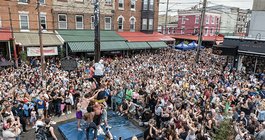
June 08, 2022
 Thom Carroll/for PhillyVoice
Thom Carroll/for PhillyVoice
Philadelphia shrank in population last year, but some pockets of the Pennsylvania, including Phoenixville and Pike County saw growth.
Pennsylvania and its largest city, Philadelphia, have been shrinking since the start of the COVID-19 pandemic. But there are some pockets of the state that are still experiencing growth.
Pennsylvania lost 38,644 people or 0.3% of its population between April 2020 and July 2021, the U.S. Census Bureau estimates. That's the sixth biggest numerical decline of any state. Pennsylvania now has an estimated 12.9 million people.
Philadelphia shed 27,546 residents, or about 1.7% of its population, during the same time frame. That's a shift from the previous decade, when the city steadily gained 77,791 residents, growing from 1.5 million residents in 2010 to 1.6 million in 2020.
It's also bigger loss than anywhere else in the state, but it falls in line with a trend seen among Pennsylvania cities. Pittsburgh, Allentown, Reading and Erie – the next four biggest cities in the state – all saw their populations decline, as well, although none by more than 1%.
Pennsylvania is facing stiff competition from the South and West.
Proportionally, the nation's three fastest-growing states – Idaho, Montana and Utah – expanded by between 1.7% and 2.9% last year, Deseret News reports. Delaware and South Carolina were tied for fifth place at 1.2%.
Texas, Arizona and Florida had the highest numerical growth, with tens of thousands of people moving to each state.
The trend of Americans from the Northeast and Midwest moving to warmer, retirement-friendly locales, where taxes and the cost of living are generally lower, predates the pandemic.
But the population shifts within Pennsylvania tell a newer story about where people moved during the pandemic.
About 60% of the 2,571 cities and towns in Pennsylvania had fewer people in July 2021 than they did one year earlier, the Morning Call reports. Also, 36 of the state's 67 counties lost population. But population declines were particularly felt hard in Pennsylvania's cities, which lost their appeal to many during the pandemic lockdowns.
That mirrors a trend seen across the country. Lots of city dwellers have moved to the suburbs or to smaller metro areas that are within a few hours drive of a major city, but not within its traditional sphere of influence.
Of the 10 Pennsylvania towns that gained the most residents from July 2020 to July 2021, three are in the Philadelphia suburbs. Phoenixville, Chester County added 438 residents – the most in the state. Downingtown, Chester County added 264 residents and Lansdale, Montgomery County added 175 residents.
Chester and Montgomery counties were among the counties that grew the most between April 2020 and July 2021. Chester County added 4,236, growing by 0.8%; Montgomery county added 4,025 residents, growing by 0.5%.
But proportionally, Pike County has grown the fastest, growing by 2.3% and adding 1,417 residents during that stretch. It's the fastest growing county due to the inflow of residents from North Jersey and the rest of the New York metro area, which generally have higher taxes.
Some of the other fastest-growing counties include Cumberland, which grew by 3,450 people or 1.3%; Carbon, which grew by 663 people or 1%; and Forest, which grew by 59 people or 0.8%.
All these counties are less than a three hour drive from Philadelphia, Pittsburgh or New York City.
But the population growth some states continue to see obscures a broader trend – U.S. population growth has stalled.
The nationwide population grew by less than 1 million people, or just 0.1%, between 2020 and 2021, Brookings reported. This is the lowest growth rate ever recorded by the U.S. Census Bureau. It contributed to populations dropping in 31 states and Washington D.C.
The country's birth rate has declined due to a rapidly aging population and the effects of the Great Recession, which left many people of child-bearing age less economically stable and therefore less likely to have kids.
A precipitous drop in immigration rates is another part of the story. The number of immigrants coming to the country has fallen by roughly 75% since former President Donald Trump was elected in 2016. The trend became even more pronounced during the pandemic.